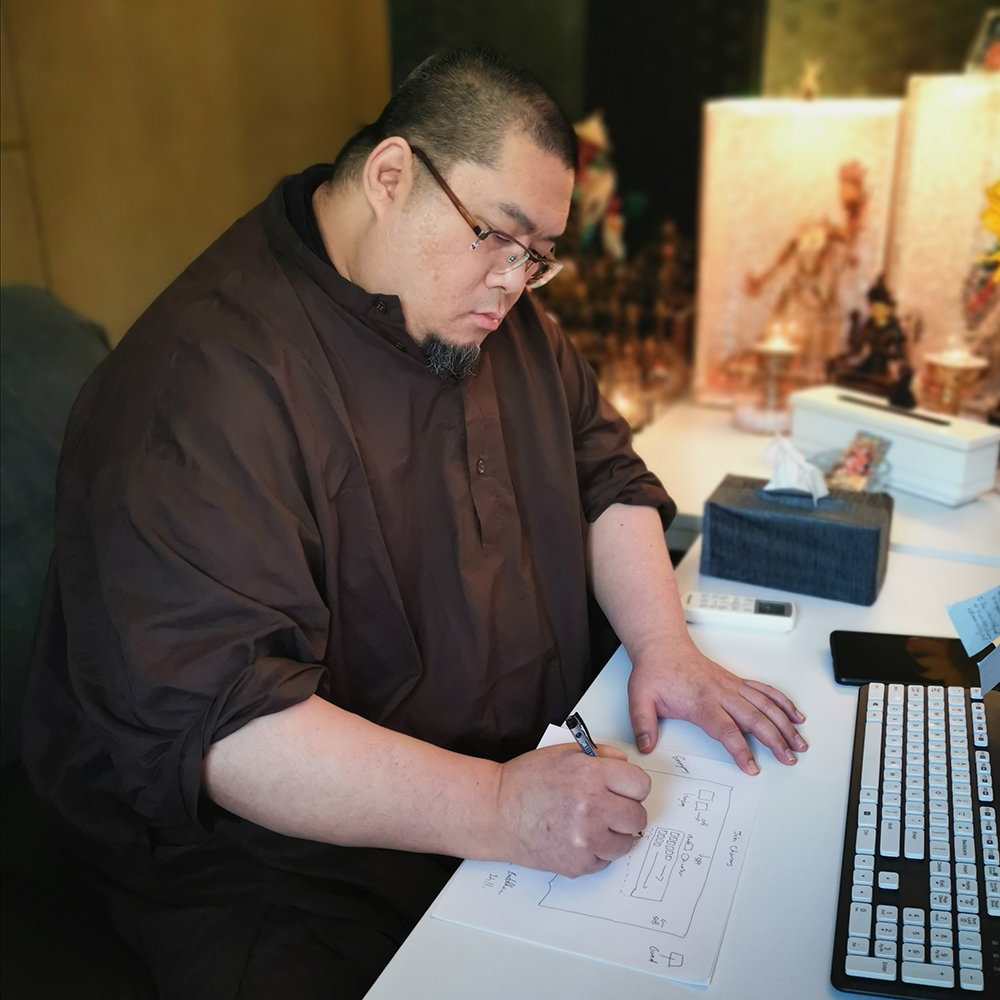Putting down roots
July 16, 2019 0

Tsem Rinpoche drawing up plans for a vegetable farm.
Rinpoche is never interested in secular activities just for the sake of it, but always uses his knowledge, interest and experience to see how he can improve the lives of those around him and how he can bring Kechara Forest Retreat (KFR) to the next level in terms of serving others. So for Rinpoche, a vegetable farm is not just a vegetable farm, but an activity that can bring Dharma to others.
Oftentimes Rinpoche will personally go around KFR to see what can be developed, improved, updated and sometimes even totally redone. This is so that everyone who comes to KFR, whether temporarily or to live here, is able to maximise the amount of merits they create. So whether it is renovating the Gyenze chapel to expand the amount of space available to make offerings, or conceptualising an entire Buddha outdoor shrine, or starting a vegetable garden, Rinpoche’s goal is very clear. No matter who steps foot on KFR land, they must leave with imprints of the enlightened mind and a sense that Dharma is something positive.
One reason why Dharma is positive is because the Buddha’s teachings can motivate us to get involved in activities we never thought possible for ourselves. One such activity for many of us city folk is farming. Over the years, Rinpoche has often expressed his wish to have a vegetable farm on our land, to cultivate crops we commonly consume in order to become more self-sustaining. One afternoon, the opportunity to start such a farm presented itself.
For those of you unfamiliar with Rinpoche’s biography, Rinpoche was farming even as a child. His adoptive mother, Dana Bugayeff, had a vegetable garden in the half-acre backyard of their house in Howell, New Jersey that Rinpoche was in charge of tending. This meant that along with his homework and the countless other household tasks and chores he was responsible for, the eight-year-old Rinpoche had to till, plant, prune, weed, trim, fertilise and harvest all on his own. You can read more about Rinpoche’s childhood farming experiences here: https://www.tsemrinpoche.com/?p=201587
More recently, Rinpoche has spoken about Findhorn and his admiration for what their community does to promote alternative ways of thinking, living, learning and healing. In a troubled world that is full of conflict, division and disharmony, communities like Findhorn which espouse values of consciousness, peace and acceptance are becoming fewer and far between. Amongst the many activities and methods promoted by Findhorn is gardening and in Rinpoche’s words, “If they can grow giant cabbages in Findhorn, why can’t we do it here too?”
So a group of students recently got together to work on this farming project. Under Rinpoche’s guidance, 80 plots have been tilled and are being readied for planting. To start with, the group will be planting:
- Okra (lady’s finger)
- Long bean
- Tomato
- Four-angle bean
- Chilli
- Cucumber
- Green / spring onion
- Lettuce
- Eggplant
- Kang kong (water convolvulus)
- Bitter gourd
- Bell peppers
All of the above are commonly-consumed items by KFR residents and visitors, and the aim for the garden is to reduce reliance on external suppliers. Have these students farmed before? No. Are they willing to? Yes. Can they learn how to? Definitely.
In the photo above, Rinpoche is drawing up the location of the plots before deciding what crops will be planted. Not only did Rinpoche design the layout of the vegetable farm, but Rinpoche also considered other future projects that will be taking place in the same location. Hence the layout of the farm also has allowances made for the materials, manpower and resources that will need to be housed there in the future. It will allow for the future projects and farming to run concurrently, so the farm will not have to be relocated until the very last minute. That means planting and harvesting can happen until the absolutely very last minute.
If you get into Dharma, it is because you think that enlightenment is possible. If enlightenment, which is the highest goal of all, is possible then surely everything else in between is possible too. Therein for me lies the beauty of a guru, which is to get you to do things you never thought possible because in doing so, it is a step closer to enlightenment…even if that step is through a humble vegetable farm.
Recent Posts
Subscribe to Blog
Categories
Archives
Visitors by Country
| Malaysia | 17,826 | |
| United States | 9,381 | |
| Russia | 2,979 | |
| China | 2,320 | |
| United Kingdom | 3,271 | |
| Mexico | 1,722 | |
| Germany | 2,251 | |
| Canada | 2,302 | |
| Nepal | 1,559 | |
| Singapore | 2,895 | |
| France | 1,169 | |
| India | 1,008 | |
| Brazil | 776 | |
| Netherlands | 1,116 |
| Total Pageviews: | 61,993 |
|---|



Leave a Reply